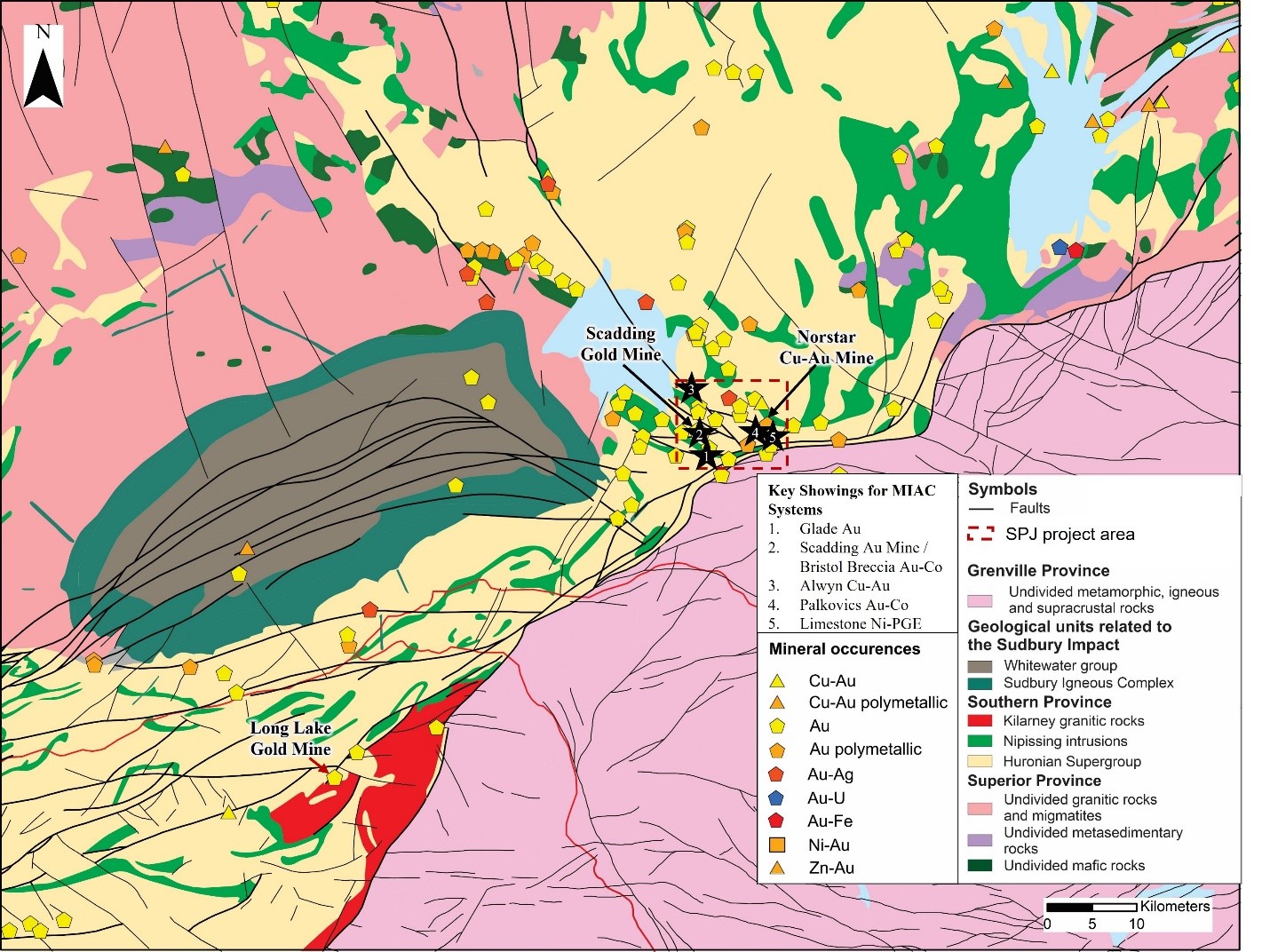The Project is situated within the Paleoproterozoic Huronian Supergroup of the Southern Province, which extends approximately 450 km from Sault Ste. Marie, Ontario, into western Quebec (Bennett et al. 1991; Figure 5). The Huronian Supergroup comprises a series of steeply dipping metasedimentary rocks with subordinate metavolcanic rocks which were deposited from 2.45-2.02 Ga in a transform rift basin (Hill, 2019; Krough et al., 1984). The Huronian group sediments were regionally folded during the 2.4-2.2 Ga Blezardian Orogeny (Riller et al., 1999). Several intrusive events occurred contemporaneously with deposition of the Huronian, including the 2.22-2.02 Ga emplacement of the Nipissing Sills (Corfu and Andrews, 1984). The Blezardian Orogeny occurred prior to the intrusion of the Nipissing Sills, which can be observed as the sills intrude across the axial plane of regional folds (Jackson, 1997). The older East Bull Lake intrusions were emplaced from 2.49-2.47 Ga (James et al., 2002).
An impact at 1.85 Ga formed the Sudbury Igneous Complex (SIC) and an impact structure over 200 km in diameter (Spray et al., 2003; Krough et al., 1984). The SIC includes the richly endowed Ni-Cu-PGE deposits for which Sudbury is famous. Although Penokean-age deformation has been dated within the SIC, the intensity of deformation imposed on the SIC by Penokean compression is still debated (Bleeker et al., 2015; Mukwakwami et al., 2014).
The Penokean Orogeny occurred from 1.86-1.82 Ga and was originally interpreted and inferred to have deformed Huronian Sediments in a north-vergent fold-and-thrust belt (Craddock et al., 2018; Piercey et al., 2007). Penokean deformation is well constrained in the Lake Superior region, but its effects elsewhere are not as well understood (Schulz and Cannon, 2007). A period of felsic magmatism occurred from 1.77-1.69 Ga. This period includes the intrusions of the Killarney granitic suite, the Eden Lake Pluton, the Cutler Batholith, the Gronodine Complex, and the Fox Island Granite (Piercey et al., 2007; Schandl and Gorton, 1994; Davidson et al., 1992). This is coeval with the Yavapai Orogeny, which occurred from 1.77-1.7 Ga. The Yapavai Orogeny is also associated with a regional albitization event in the Southern Province that is documented over a strike length of at least 340km. This event was dated at 1.7 Ga with a possible component at 1.74 Ga at the Scadding Mine Site (Schandl and Gorton, 1994), indicating that albitization is associated temporally with the Yapavai Orogeny and the emplacement of the Killarney granites.
MacDonald’s observation on the SPJ project indicate that the albitites resulting from regional sodic alteration in the Southern Province are folded, brecciated and deformed. These observations indicate that the Penokean Orogeny probably is not associated with significant deformation on the SPJ project, but instead that the Yavapai Orogeny represent peak deformation in the Sudbury region. This is supported by regional structural work in the Sudbury area that indicates that the Sudbury region was considerably reworked during the Yavapai Orogeny (Papapavlou et al., 2018).

Local Geology
Local geology comprises metasedimentary rocks of the Huronian Supergroup, mafic intrusive rocks belonging to the Nipissing and Sudbury groups, and high-grade metamorphic rocks of the Grenville province.
Rocks belonging to the Hough Lake, Quirke Lake, and Cobalt groups comprise the local geology of the SPJ project. Mafic intrusions belonging to the Nipissing and Sudbury intrusive swarms are also present. Rocks of the Upper Hough Lake group, the Quirke Lake group, and the Nipissing Diabase contain localized corridors of strong albite alteration which is associated with gold mineralization in the area. Albitization is dated at 1700 ± 2 Ma on the Property, which is contemporaneous with a period of felsic plutonism from 1750-1700 Ma (Schandl and Gorton, 1994). Albitization is interpreted to be the result of the release of brines during this period of alkali magmatism.
The Murray Fault, a crustal-scale east-west fault, is found south-southwest of the Property. This major fault system was active prior to Huronian sedimentation and continued to be active during sedimentation and through to Grenvillian deformation (Fuetan and Redmond, 1992). Open to sub-isoclinal folding with well-developed foliations trending parallel to the Murray Fault are documented (Murphy, 1999). The NNW-striking McLaren Lake Fault and its associated splays are spatially associated with mineralized vein occurrences (Potter, 2009).
The Grenville Front is located to the south of the Property. The boundary can be seen very clearly using magnetics. The overprinting effects of the Grenville Front can also be observed in the deformation of Nipissing diabase, which tend to deform/bend into the Grenville front within the south-southeastern portion of the property.
Mineralization Events
The SPJ project area historically has been affected by numerous tectonic and thermal events, which have enhanced the crustal permeability. Within our property we have evidence of two specific events that have created many episodes of precious and critical metal mineralization: the Nipissing Event around 2.2 Ga and the Scadding event around 1.7 Ga
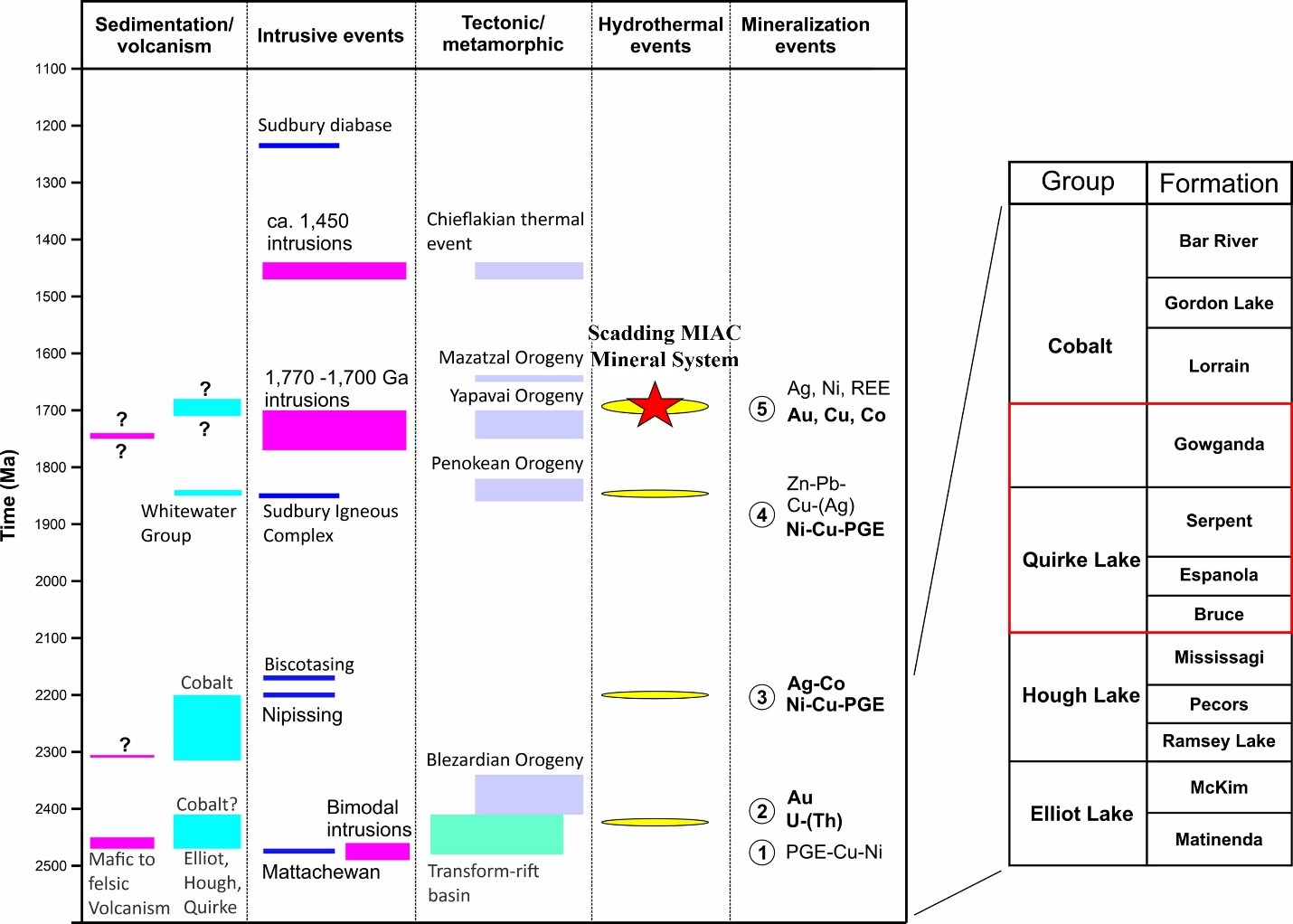
Nipissing Event (~2.2. Ga):
- Magmatic Ni-Cu-PGE mineralization
- Mineralized Nipissing Intrusions present on SPJ Property (e.g. Candore showing, Jerome showing, Glade – see tab for Magmatic Ni-Cu-PGE targets for additional details)
- MDI database indicate different centers of Ni-Cu-(Au-PGE) mineralization
- Ag-Co mineralization (Cobalt Area)
Examples of the Nipissing Event on the SPJ Property– Ni-Cu-PGE mineralization
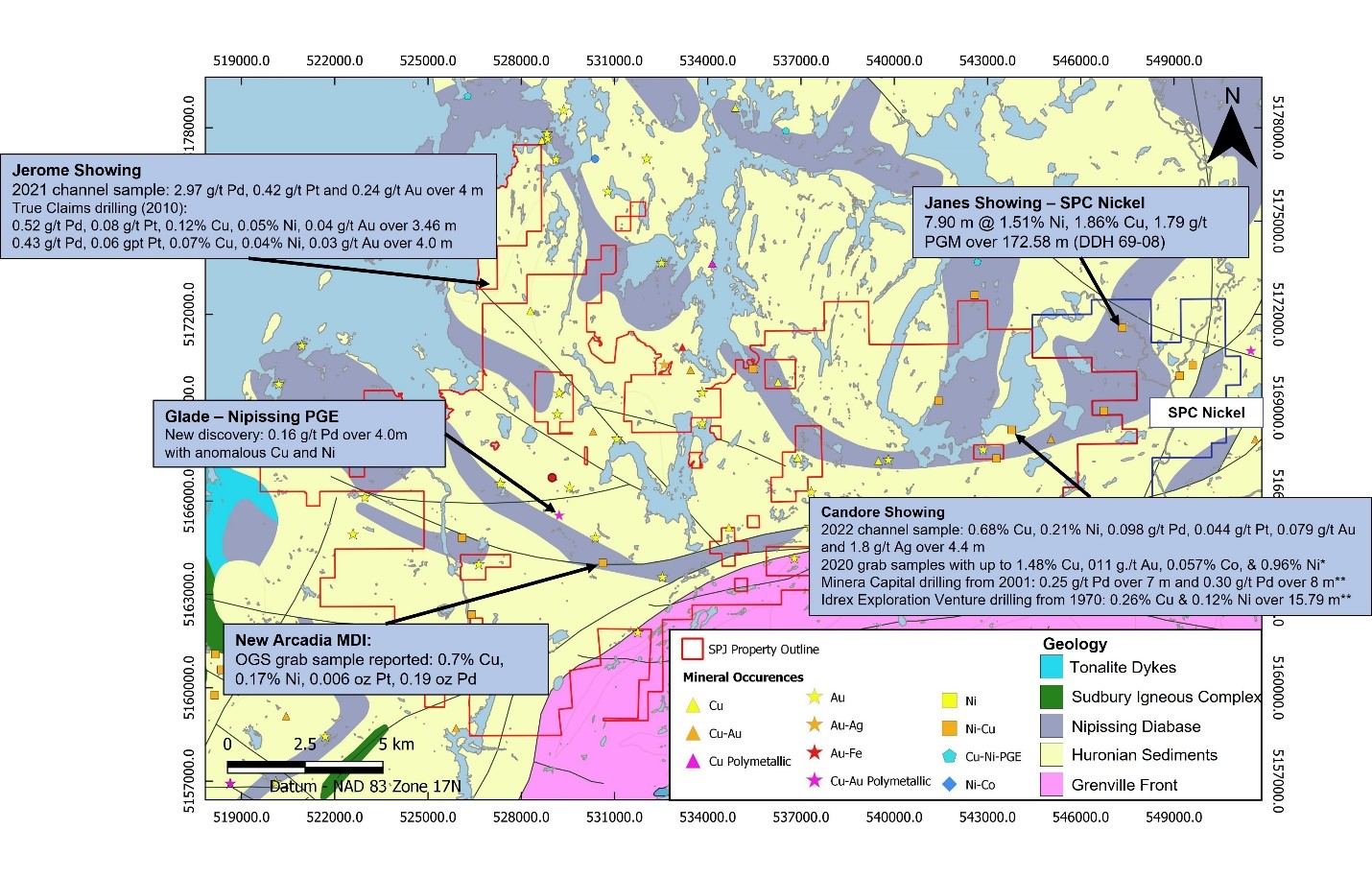
Regional Examples of Nipissing Event – Ni-Cu-PGE mineralization
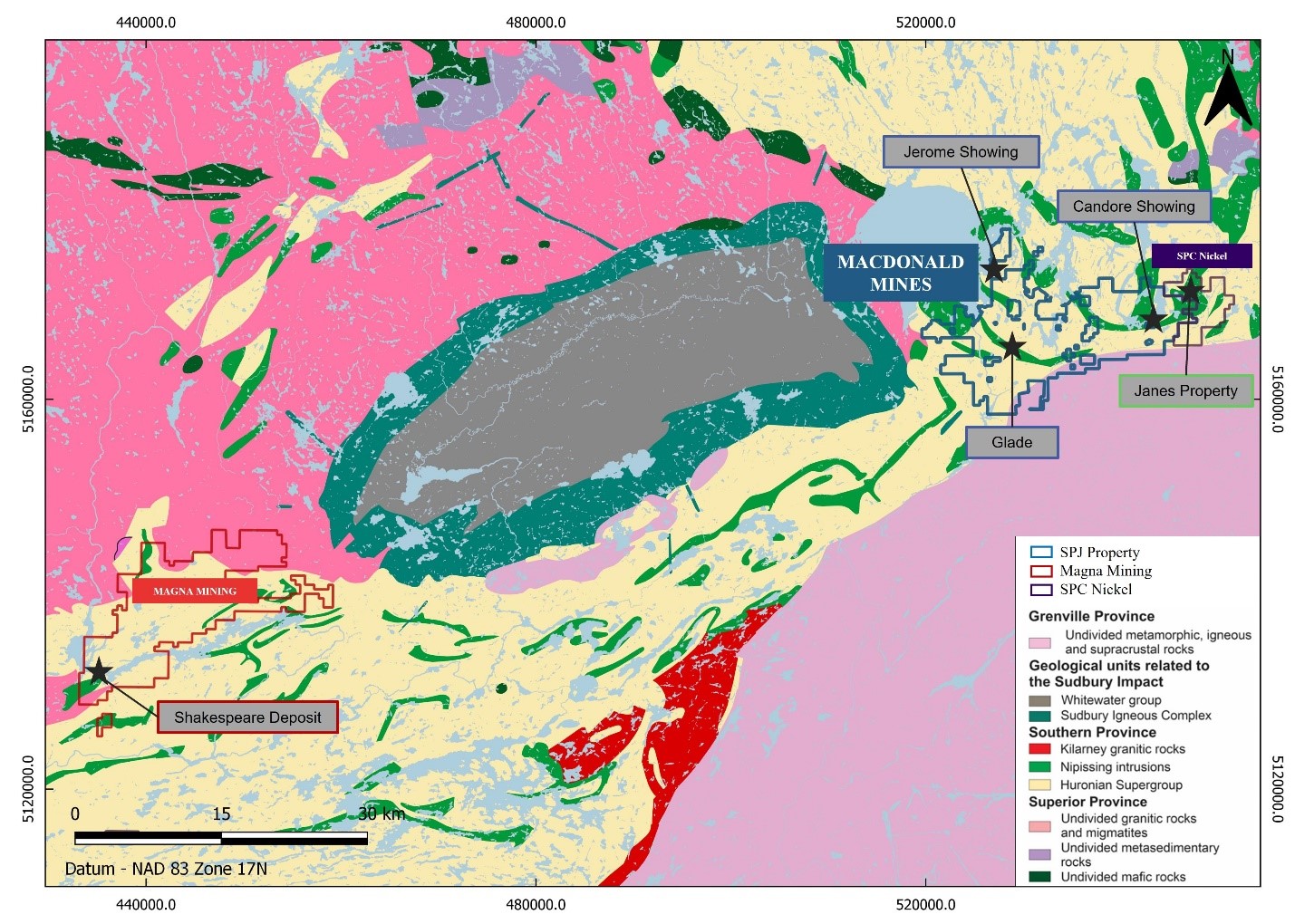
Janes Property – SPC Nickel: Ni-Cu-PGE mineralization in the footwall of a folded Nipissing sill as:
- Disseminated sulfides: 2.71g/t PGM, 1.01% Cu, 0.27% Ni over 18.05m at 32.0m (DDH JR99 01)*
- Massive sulfides: 1.51% Ni, 1.86% Cu, 1.79g/t PGM over 7.9m at 172.8m (DDH 69 08)*
- Shear-hosted high-grade sulfides (likely remobilization during the Scadding event): 1,715g/t Pd, 17.25g/t Pt, 109.5g/t Au. 0.23% Cu, 0.23% Cu (grab)*
Shakespeare Project – Magna Mining: Located 70 km south-west of Sudbury. Resource calculations include:
- M&I: 20.34 Mt @ 0.55% NiEq;
- Inferred: 2.36 Mt @ 0.57% NiEq
*The reader is cautioned that the above information is not necessarily indicative of comparable mineralization on BMK’s SPJ property
Scadding MIAC Mineral System (~1.7 Ga)
- Regional albitization extending from Bruce Mines to Temagami (Gates, 1991) associated with Au-Cu-(Co-Ni) and Au mineralization
- Greatest intensity recognized so for is east of the Sudbury Igneous Complex, south and east of Lake Wanapitei surrounding the SPJ Property
- Corresponds to the area of highest intensity of polymetallic gold mineralization
- Metamorphic sodic alteration zones described in the Grenville Front Tectonic Zone (Gates, 1991)
- Sodic alteration is very intense, reaching up to 10 wt. % Na2O, however has often been misidentified as quartzite, silicification or chert.
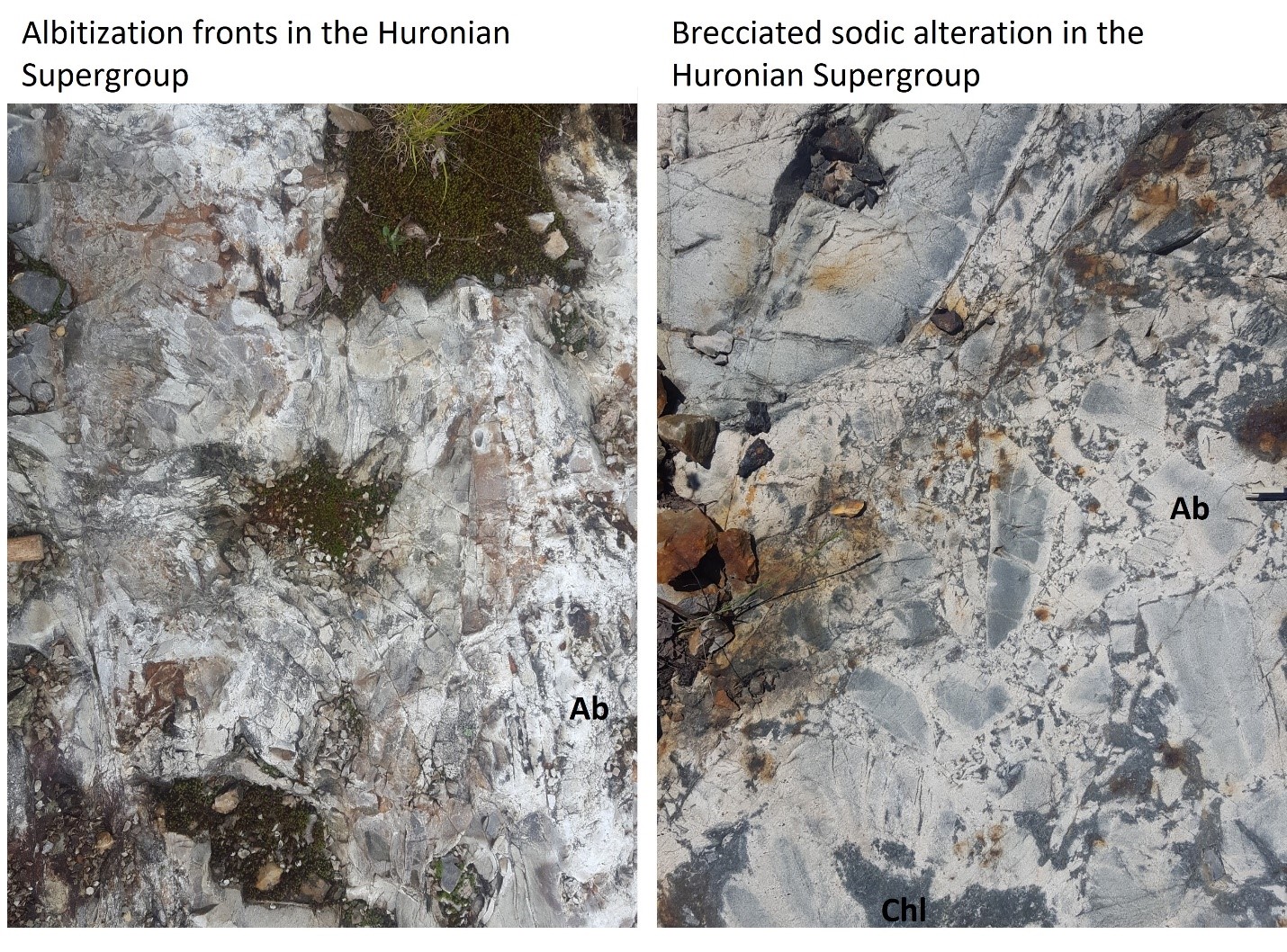
- Sodic alteration zones are preferential hosts of polymetallic gold mineralization, including the Scadding deposit and the historic Long Lake Gold Mine
